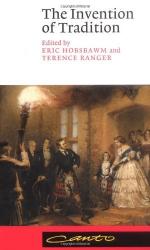
|
| Name: _________________________ | Period: ___________________ |
This test consists of 5 multiple choice questions, 5 short answer questions, and 10 short essay questions.
Multiple Choice Questions
1. The old Welsh histories held that they were the _____ people of the British Islands.
(a) Most beautiful.
(b) Strongest.
(c) Eldest.
(d) Youngest.
2. The author suggests that invented traditions have mostly arisen in the last ______ hundred years.
(a) Two.
(b) One.
(c) Three.
(d) Four.
3. The author states that the invention of tradition involves _______ and ritualization with reference to the past.
(a) Formalization.
(b) Infrastructure.
(c) Institutionalization.
(d) Inspiration.
4. The invented traditions referred to in question 17 include all of the following types except _______.
(a) Traditions that promote socialization.
(b) Traditions that establish or symbolize social cohesion.
(c) Traditions that legitimize institutions of authority.
(d) Traditions that seek to usurp authority.
5. According to the book, Welsh scholars and patriots rediscovered past traditions in all of the following areas except ______.
(a) Linguistic.
(b) Historical.
(c) Literary.
(d) Musical.
Short Answer Questions
1. Hobsbawm claims that new invented traditions tend to be _____ and not binding, and inculcate general values.
2. _______ decided that Welsh culture should be preserved and helped develop the invention of a tradition.
3. In chapter one, the author introduces his concept of ________ which are tied to false histories and have contemporary origins.
4. Hobsbawm asserts that the overtly or tacitly accepted rules of traditions must have a ______ nature.
5. The author asserts that attitudes were ______ in Wales and thus there was a loss of cultural self-confidence.
Short Essay Questions
1. What does the author mean in this manuscript when he says that traditions have tacit rules?
2. How does the author use the term 'invented tradition' in this manuscript?
3. What did Welsh scholars and patriots rediscover about their past as they began to notice interest declining?
4. What happened as a result of a loss of cultural self confidence, according to the book?
5. Why was it surprising that the Welsh cultural life was beginning to fall apart in the eighteenth to early nineteenth century?
6. What did James Macpherson do in order to help invent the history of the Scottish people?
7. What are the invented concepts of which more sense can be made by the study of invented traditions?
8. Why should historians be more aware of the tradition phenomena that occurs in modern society?
9. Where can exceptions to traditions be found, though some traditions have filled in the space abandoned by secular decline?
10. What did the oldest part of the history say about the Welsh and the people of Wales?
|
This section contains 583 words (approx. 2 pages at 300 words per page) |

|




